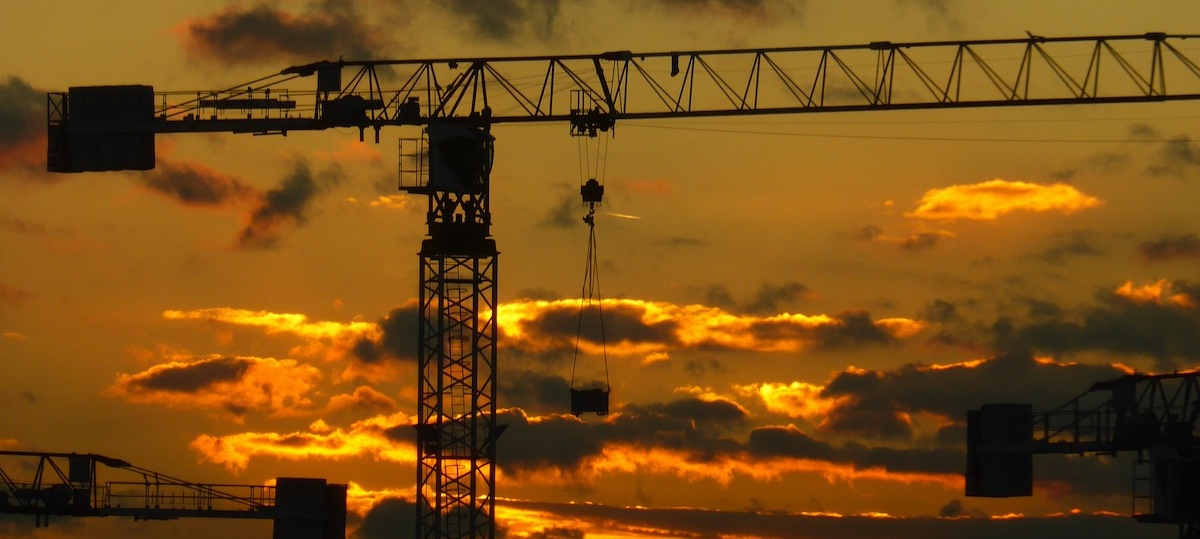Today's Census Bureau release regarding nonresidential construction spending did not just offer good news about April, it also supplied upwardly revised spending data for both February and March.
Nonresidential spending expanded 3.2% on a monthly basis in April, and spending totaled $646.7 billion on a seasonally adjusted, annualized basis, according to the government's initial estimate. Nonresidential construction is up by a solid 8.8% over the past year, consistent with ABC's forecast of high single-digit growth.
The Census Bureau also revised March's nonresidential spending figure from $611.8 billion to $626.7 billion, and February's figure from $613.1 billion to $618.4 billion. Initial estimates suggested that nonresidential construction was sagging during the early months of the year; however, the new data indicate spending has expanded during each of the previous three months.
"There is a considerable amount of financial capital available to move construction projects forward and low interest rates certainly help. While the availability of substantial financial capital may eventually produce over-built private construction markets, for now the expectation is that progress will continue." —Anirban Basu, ABC Chief Economist
"The upbeat assessment of nonresidential construction in April has been rendered more meaningful by the upward revisions for prior months," said ABC Chief Economist Anirban Basu. "The presumption had been that nonresidential spending construction data would improve as we approached the summer, and the outlook ahead remains solid.
"There is a considerable amount of financial capital available to move construction projects forward and low interest rates certainly help," added Basu. "While the availability of substantial financial capital may eventually produce over-built private construction markets, for now the expectation is that progress will continue."
All but one nonresidential construction sector experienced spending increases in April:
• Manufacturing-related construction spending expanded 2.6% in April and is up a whopping 52.9% on a yearly basis.
• Office-related construction spending expanded 3.7% in April and is up 8.8% compared to the same time one year ago.
• Construction spending in the transportation category grew 1.6% on a monthly basis and has expanded 11.6% on an annual basis.
• Lodging-related construction spending was up 5.5% on a monthly basis and 17.6% on a year-over-year basis.
• Health care-related construction spending expanded 2.1% for the month and is up 2.6% compared to the same time last year.
• Spending in the water supply category expanded 0.7% from March and is up 0.8% on an annual basis.
• Public safety-related construction spending gained 2.3% on a monthly basis, but is down 5.6% on a year-over-year basis.
• Commercial construction spending expanded 2.7% in April and is up 17.5% on a year-over-year basis.
• Religious spending gained 3.3% for the month, but is down 7.8% compared to the same time last year.
• Sewage and waste disposal-related construction spending gained 0.5% for the month and has grown 14.9% on a 12-month basis.
• Power-related construction spending grew 2.5% for the month, but is 11.3% lower than the same time one year ago.
• Highway and street-related construction spending expanded 8.5% in April and is up 4.8% compared to the same time last year.<
• Conservation and development-related construction spending grew 3.7% for the month and is up 17.2% on a yearly basis.
• Amusement and recreation-related construction spending improved 2.5% on a monthly basis and is up 23.3% from the same time last year.
• Education-related construction spending gained 3.2% for the month and is up 0.4% on a year-over-year basis.
Spending declined in only one nonresidential construction subsector in April:
• Communication-related construction spending fell 5.9% for the month and is down 5.5% for the year.
To view the previous spending report, click here.
Related Stories
Contractors | Jun 22, 2023
Chris Averill named President of Pepper Construction Group
Pepper Construction Group is pleased to announced the promotion of Chris Averill to the position of President. In his new role, Averill will assume leadership responsibility for the Pepper Construction Group’s growth and performance.
Industrial Facilities | Jun 20, 2023
A new study presses for measuring embodied carbon in industrial buildings
The embodied carbon (EC) intensity in core and shell industrial buildings in the U.S. averages 23.0 kilograms per sf, according to a recent analysis of 26 whole building life-cycle assessments. That means a 300,000-sf warehouse would emit 6,890 megatons of carbon over its lifespan, or the equivalent of the carbon emitted by 1,530 gas-powered cars driven for one year. Those sobering estimates come from a new benchmark study, “Embodied Carbon U.S. Industrial Real Estate.”
Virtual Reality | Jun 16, 2023
Can a VR-enabled AEC Firm transform building projects?
With the aid of virtual reality and 3D visualization technologies, designers, consultants, and their clients can envision a place as though the project were in a later stage.
Mechanical Systems | Jun 16, 2023
Cogeneration: An efficient, reliable, sustainable alternative to traditional power generation
Cogeneration is more efficient than traditional power generation, reduces carbon emissions, has high returns on the initial investment, improves reliability, and offers a platform for additional renewable resources and energy storage for a facility. But what is cogeneration? And is it suitable for all facilities?
AEC Innovators | Jun 15, 2023
Rogers-O'Brien Construction pilots wearables to reduce heat-related injuries on jobsites
Rogers-O'Brien Construction (RO) has launched a pilot program utilizing SafeGuard, a safety-as-a-service platform for real-time health and safety risk assessment. Non-invasive wearables connected to SafeGuard continuously monitor personnel to prevent heat exhaustion on jobsites, reducing the risk of related injuries. RO is the first general contractor to pilot this program.
Office Buildings | Jun 15, 2023
An office building near DFW Airport is now home to two Alphabet companies
A five-minute drive from the Dallas-Fort Worth International Airport, the recently built 2999 Olympus is now home to two Alphabet companies: Verily, a life sciences business, and Wing, a drone delivery company. Verily and Wing occupy the top floor (32,000 sf and 4,000 sf, respectively) of the 10-story building, located in the lakeside, work-life-play development of Cypress Waters.
Transit Facilities | Jun 15, 2023
Arlington, Va., transit station will support zero emissions bus fleet
Arlington (Va.) Transit’s new operations and maintenance facility will support a transition of their current bus fleet to Zero Emissions Buses (ZEBs). The facility will reflect a modern industrial design with operational layouts to embrace a functional aesthetic. Intuitive entry points and wayfinding will include biophilic accents.
Urban Planning | Jun 15, 2023
Arizona limits housing projects in Phoenix area over groundwater supply concerns
Arizona will no longer grant certifications for new residential developments in Phoenix, it’s largest city, due to concerns over groundwater supply. The announcement indicates that the Phoenix area, currently the nation’s fastest-growing region in terms of population growth, will not be able to sustain its rapid growth because of limited freshwater resources.
Multifamily Housing | Jun 15, 2023
Alliance of Pittsburgh building owners slashes carbon emissions by 45%
The Pittsburgh 2030 District, an alliance of property owners in the Pittsburgh area, says that it has reduced carbon emissions by 44.8% below baseline. Begun in 2012 under the guidance of the Green Building Alliance (GBA), the Pittsburgh 2030 District encompasses more than 86 million sf of space within 556 buildings.
Industry Research | Jun 15, 2023
Exurbs and emerging suburbs having fastest population growth, says Cushman & Wakefield
Recently released county and metro-level population growth data by the U.S. Census Bureau shows that the fastest growing areas are found in exurbs and emerging suburbs.

















